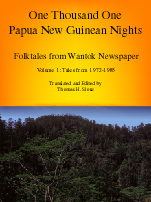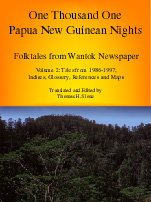One Thousand One Papua New Guinean Nights


Description ·
What Reviewers Have Said ·
Sample Folktales ·
References ·
Purchase
The book can be ordered from Masalai Press
Wantok, the Pidgin English (Tok Pisin) newspaper of Papua New Guinea (PNG),
has published a series of folk tales sent in by readers from around the country since 1972. I have collected and edited these folk tales, and have translated them into English through 1997. I have indexed them by author, village, original language,
province, flora and fauna, and motif. There is also a
list of folktale titles that I have translated into English.
Rather than index culture group, which is not well-standardized in PNG, the name
of the local language
used in the village from which each story originates is indexed. The names for the language index are
primarily based on Dutton (1973), Laycock (1973), Wurm (1975), Wurm (1976), Wurm and
Hattori (1983), and Z’graggen (1975). Generally, only distinct languages are indexed, not dialects.
The current count of languages in the index is 247. This represents 35% of Papua New Guinea’s
total language count (about 700, according to Wurm, 1985). There are probably stories in the manuscripts from many culture groups that have not elsewhere had their folk tales published.
All of PNG’s provinces are represented as well as one story each from the Torres Strait of
Australia and Biak in Irian Jaya. Some provinces are better represented than others, particularly
those in which Tok Pisin is the lingua franca.
A motif index (based on Thompson, 1993; Kirtley, 1955; Kirtley, 1971; Legman, 1968; Legman, 1975; and Hoffmann, 1973) is included.
A set of maps showing the known locations of villages is included. The village locations are based on the village gazetteer by Peterson et al. (1982).
An analysis of these folk tales, probably including folk tale data from other
sources. The analysis would address the recent debate on the influence of language and proximity on cultural transmission is in progress (e.g. see Welsch et al., 1992; Moore and Romney, 1994; Roberts Jr., et al., 1995). [See also the New Guinea Research Program.]
What Reviewers Have Said
- Library Journal (February 15, 2002): “Both extraordinary and overwhelming”, “monumental”, “exemplary indexes”
- Geoff P. Smith, author of Growing Up with Tok Pisin (2002): “Monumental”
- Rundbrief (February 2002): “Zunächst einmal ist die riesige Arbeitsleistung bemerkenswert.” [First of all this enormous work is remarkable.]
- Swag of Yarns: Australia’s National Storytelling Magazine (Winter 2002): “A parcel of gold” “This remarkable collection of ancestor stories from Papua New Guinea’s oral tradition is for serious collectors and lovers of oral stories-gold to the storyteller.” “Amazing”
Below are four sample folktales in the original Tok Pisin:
and my translations into English:
I have described my technique for determining the languages associated with PNG villages
here.
Despite my substantial effort at this, there are still villages that I have been unable to precisely locate. These are located
here. If you know where any of these are, please
contact me.
I have been unable to locate issue number 1138 from 1996 of Wantok. Please please let me know if you can send me the ancestor story from this issue.
References
-
Dutton, Tom E. (1973). A Checklist of Languages and Present-Day Villages of Central and South-East Mainland Papua. Series B, Number 24. Canberra: Pacific Linguistics, The Australian National University.
-
Hoffmann, Frank (1973). Analytical Survey of Anglo-American Traditional Erotica. Bowling Green, OH: Bowling Green University Popular Press.
-
Kirtley, Bacil Fleming (1955). A Motif-Index of Polynesian, Melanesian, and Micronesian Narratives. Ph.D. Thesis, Indiana University. This was reprinted in the Folklore of the World Series by Ayer Company (New York).
-
Kirtley, Bacil Fleming (1971). A Motif-Index of Traditional Polynesian Narratives. Honolulu: University of Hawaii Press.
-
Laycock, Donald C. (1973). Sepik Languages -- Checklist and Preliminary Classification. Series B, Number 25. Canberra: Pacific Linguistics, The Australian National University.
-
Legman, Gershon (1968). Rationale of the Dirty Joke: An Analysis of Sexual Humor. First Series. New York: Grove Press.
-
Legman, Gershon (1975). No Laughing Matter. Rationale of the Dirty Joke: An Analysis of Sexual Humor. Second Series. New York: Bell.
-
Moore, Carmella. C. & Romney, A. Kimball (1994). Material culture, geographic propinquity, and linguistic affiliation on the north coast of New Guinea: a reanalysis of Welsch, Terrell, and Nadolski (1992). American Anthropologist 96: 370-396.
-
Peterson, Boyd D., Garren, William R., and Heyda, Charles M. (1986). Gazetteer of Papua New Guinea: Names Approved by the United States Board on Geographical Names. Washington, DC: Defense Mapping Agency, 588 pp.
-
Roberts, Jr., John M., Moore, Carmella. C. & Romney, A. Kimball (1995). Predicting similarity in material culture among New Guinea villages from propinquity and language. Current
Anthropology 36: 769-788. [including replies]
-
Thompson, Stith (1993). Motif-Index of Folk-Literature. Bloomington: Indiana
University Press, CD-ROM ed.
-
Welsch, Robert L., Terrell, John & Nadolski, John A. (1992). Language and culture on the north coast of New Guinea. American Anthropologist 94: 568-600.
-
Wurm, S. A. (1975). New Guinea Area Languages and Language Study. Volume 1. Papuan Languages and the New Guinea Linguistic Scene. Pacific Linguistics, Series C, No. 38. Canberra: Australian Academy of the Humanities.
Wurm, S. A. (1976). New Guinea Area Languages and Language Study. Volume 2. Austronesian Languages. Pacific Linguistics, Series C, No. 39. Canberra: Australian Academy of the Humanities.
-
Wurm, Stephen A. (1985). “Indigenous languages.” In: Papua New Guinea Atlas: A Nation in Transition, David King & Stephen Ranck, eds. Bathurst, New South Wales: Robert Brown.
-
Wurm, S. A. & Hattori, Shirô, eds. (1983). Language Atlas of the Pacific Area. Part I. New Guinea Area, Oceania, Australia. Pacific Linguistics, Series C, No. 67. Canberra: Australian Academy of the Humanities.
-
Z’graggen, John A. (1975). The Languages of the Madang District, Papua New Guinea. Pacific Linguistics, Series B, No. 41. Canberra, Australia:
See also: An annotated bibliography of Papua New Guinean folklore
This site has received an award by The Creolist Archives 
home page.
© 2001 by Thomas H. Slone.
Last modified September 24, 2002.



